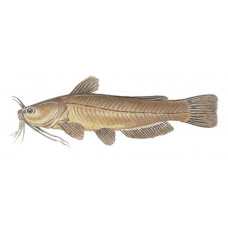Latin name
Ameiurus natalis
Other names
Yellow cat, creek cat, white-whiskered bullhead, greaser.
Identification
A moderately slender fish, it has skin without scales. The coloration varies from yellowish-olive to brown or almost black on the back with yellowish-olive or brown flanks, yellow or white belly, and dusky fins. Juveniles are dark brown or blue-black. The rounded tail helps distinguish the yellow bullhead from other bullheads, which have square or truncated tails. The yellow bullhead has sharp, tooth-like serrations on the posterior edge of the spine at the top of the pectoral fins. The chin spines are white, yellow, or pale pink.
Distribution
The yellow bullhead inhabits much of central and eastern North America, extending east from New York to Florida and west from southern Quebec to central North Dakota and south to the Gulf of Mexico. Like other bullhead species, this fish has also been introduced outside its original range.
Habitat
Preferring clear water, gravel or rocky bottoms, sluggish currents, and dense vegetation, the yellow bullhead is found in pools, ponds, streams, small and large rivers, and shallow, shallow lakes. They are common in small, weedy and shallow water bodies and are more tolerant of polluted water and low oxygen levels than most other bullhead species. They are most abundant in water temperatures between 75° and 80 °F.
Size
Yellow bullheads usually weigh less than a pound, although they sometimes reach 3 pounds. The most common length is 7 to 11 inches, but they can reach 18.3 inches in length. The world record holder is a specimen weighing 4 pounds 4 ounces. The yellow bullheads can live up to 7 years.
Life history and Behavior
In May and June, sexually mature fish 3 years of age and older move into shallow water when water temperatures are above 60 or below 70 degrees.
Food and feeding habits
Yellow bullheads are nocturnal scavengers that feed by smell and taste. They feed on crustaceans, immature aquatic insects, snails, small fish, dragonfly nymphs, crayfish, mollusks, and bits of aquatic vegetation.
Reproduction
Having found a suitable site, one or both parents build a nest, which is either a shallow depression in the open, or a burrow 2 feet deep in the bank in a sheltered area. The male guards the eggs and the fry hatch after 5–10 days, after which the young continue to be guarded by the male in a tight group until they can defend themselves.
| Classification | |
| Phylum | Chordata |
| Class | Actinopterygii |
| Squad | Siluriformes |
| Family | Ictaluridae |
| Genus | Ameiurus |
| Species | A. natalis |
| Features | |
| Conservation status | Least Concern |
| Habitat | Bottom |
| Life span, years | 12 |
| Maximum body weight, kg | 2.892 |
| Maximum length, cm | 35.56 |
| Sailing speed, m/s | No information |
| Threat to people | Edible |
| Way of eating | Predator |


